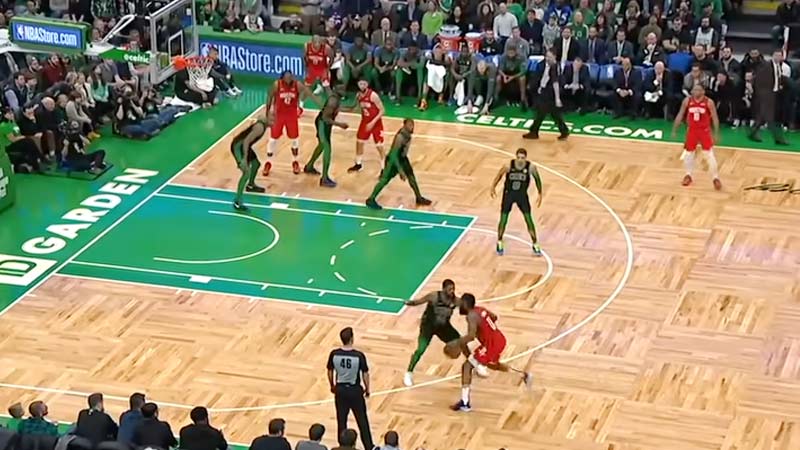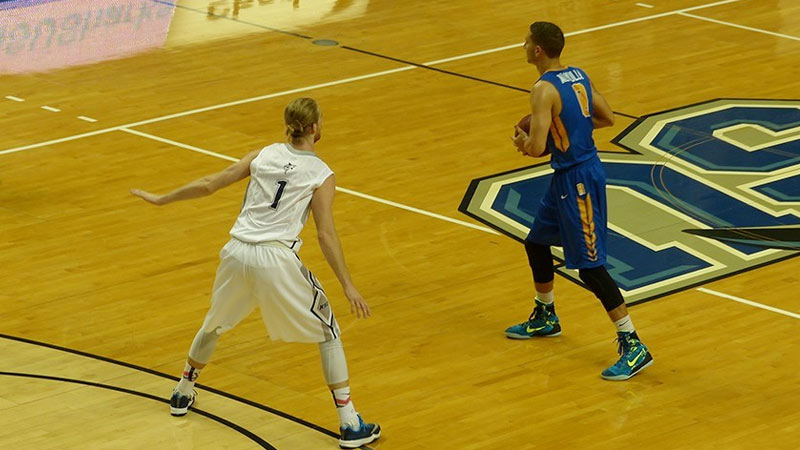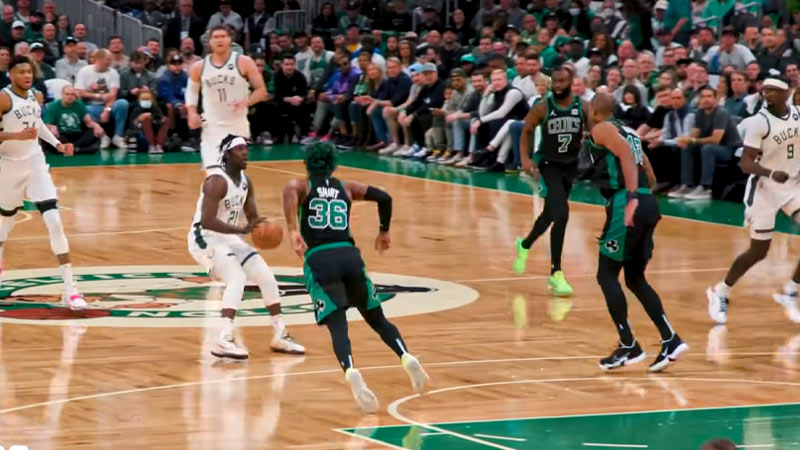Basketball is a thrilling and dynamic sport that captivates fans worldwide with its fast-paced action and skillful plays. Among the various elements that shape the game, the “restricted area” holds a significant role in defining offensive and defensive strategies.
Also known as the “paint” or “key,” this area surrounding the basket has specific rules that impact player movements and determine fouls.
In this blog post, we will explore the concept of the restricted area in basketball, its dimensions, its significance in the game, and how it affects players’ decisions on the court.
What is a Restricted Area in Basketball?
The restricted area in basketball, often referred to as the “paint” or “the key,” is a crucial marked area on the court situated just below the hoop. It is a semi-circle extending 4 feet from the center of the basket to the free-throw line.
The primary purpose of the restricted area is to regulate player positioning during offensive drives and defensive plays near the rim.
Defensively, the restricted area is significant in charging fouls. When an offensive player initiates a drive to the basket, defenders must establish a legal guarding position outside the restricted area before the offensive player takes off for a layup or dunk.
If the defender is inside the restricted area at the moment of impact, a blocking foul is called on the defender instead of a charging foul on the offensive player.
Offensively, the restricted area offers a slight advantage. If an offensive player takes off from inside the restricted area and is fouled while attempting a shot, they are awarded free throws regardless of the shot’s outcome.
Criteria of the Restricted Area in Basketball

The restricted area has the following characteristics:
Location
The restricted area is situated in the immediate vicinity of the basket, directly under the hoop. It is typically a semi-circle with a radius of 4 feet (approximately 1.22 meters) extending from the center of the basket to the outer edge of the semi-circle.
Defensive Rule
The primary purpose of the restricted area is to enforce specific defensive rules known as the “defensive three-second rule.” According to this rule, a defensive player is not allowed to remain inside the restricted area for more than three consecutive seconds if they are not actively guarding an offensive player.
This rule prevents defensive players from camping in the paint and inhibiting offensive players’ movement and scoring opportunities.
Blocking and Charging
The restricted area also plays a role in determining charging and blocking fouls. When an offensive player is driving to the basket for a layup or dunk attempt, a defensive player must establish a legal defensive position outside the restricted area to draw a charging foul.
If the defensive player is inside the restricted area, they are not considered to have established a legal guarding position, and a blocking foul is called against the defender instead.
Free Throws
In certain game situations, the restricted area can affect the number of free throws awarded. If a shooting foul occurs within the restricted area, and the offensive player attempts a shot, the fouled player may be awarded an additional free throw (also known as an “and-one” situation) if the shot is successful.
The restricted area is an essential part of basketball’s rules and regulations, contributing to fair play, offensive flow, and defensive positioning during gameplay.
Its specific designations and functions make it an integral part of the game, ensuring balanced competition and strategic decision-making by players and coaches.
Significance of the Restricted Area in Basketball

Source: nsusharks.com
The restricted area, also known as the “paint” or “key,” is a crucial element of basketball that holds significant importance in the game. It is the rectangular area painted on the court directly in front of the basket, extending from the baseline to the free-throw line. The restricted area serves several essential purposes in the game:
Defensive Limitations
The primary significance of the restricted area lies in its defensive implications. When an offensive player drives toward the basket, the defensive player guarding them cannot draw a charging foul if they are standing inside the restricted area. This rule is in place to protect offensive players from severe collisions when attacking the rim.
Enhancing Offensive Play
The restricted area encourages offensive players to drive to the basket and attempt layups or dunks. It creates a high-scoring zone close to the hoop and promotes aggressive offensive play, which adds excitement and dynamism to the game.
Penalty on Defensive Fouls
If a defender commits a shooting foul against an offensive player inside the restricted area, it often results in more severe penalties for the defending team. The fouled player is granted free throws, which are high-percentage scoring opportunities, leading to potential easy points for the offensive team.
Shot Clock Considerations
The restricted area influences shot clock decisions. Offensive players driving into the paint might have limited time to finish their shot due to the presence of defenders. This can impact the shot selection and overall pace of the game.
Balanced Gameplay
The restricted area helps maintain a balance between offensive and defensive strategies. It prevents defensive players from “camping” near the basket for extended periods, ensuring they actively contest shots and play defense further away from the hoop.
Strategies and Space Management
Coaches and teams must consider the restricted area when designing offensive plays and defensive strategies. Utilizing spacing and ball movement effectively around the paint can lead to higher-percentage shots, making the restricted area a critical consideration in offensive planning.
The restricted area is a fundamental aspect of basketball, contributing to player safety, strategic gameplay, and the overall flow of the game.
By delineating an area close to the basket with specific defensive rules and offensive advantages, the restricted area enhances the excitement and competitiveness of basketball while promoting both skillful attacking and disciplined defense.
Dimension of the Restricted Area in Basketball
The dimensions of the restricted area in basketball can vary slightly based on different leagues and governing bodies.
However, the standard dimensions of the restricted area in most professional and international basketball competitions, including NBA and FIBA (International Basketball Federation) games, are as follows:
Length and Width
The restricted area extends 4 feet (approx. 1.22 meters) from the center of the basket toward the baseline in basketball. The restricted area has a width of 12 feet (approx. 3.66 meters).
Shape
The restricted area is trapezoidal in shape. It starts with a width of 12 feet under the basket, and then it gradually expands into the free-throw lane, forming a trapezoid-like region.
Purpose
As mentioned earlier, the restricted area is an important area in basketball with specific rules that limit defensive actions when an offensive player is driving to the basket.
It is designed to promote player safety, enhance offensive play near the rim, and create a balanced gameplay experience.
It’s important to note that while the dimensions are standardized in professional competitions, they may vary in other levels of play or different basketball organizations, although the general concept and purpose of the restricted area remain consistent across the sport.
Rules of Basketball Restricted Area
The rules of the basketball restricted area, also known as the “paint” or “key,” are crucial for player safety and determining defensive limitations during offensive drives to the basket. Here are the main rules governing the restricted area:
Defensive Limitations
The primary purpose of the restricted area is to protect offensive players from severe collisions when driving toward the basket. When an offensive player is within the restricted area, the defensive player cannot draw a charging foul.
This means that if the defensive player is standing inside the restricted area and the offensive player makes contact with them while attempting a shot, a charging foul is not called, and the defensive player has not rewarded possession of the ball.
Offensive Player Positioning
Offensive players should be aware of their positioning when driving to the basket. They must avoid charging into a defender who is already established in the restricted area to avoid committing a charging foul.
Defensive Player Positioning
Defensive players must position themselves carefully to draw a charging foul when guarding an offensive player driving toward the basket.
To draw a charging foul, the defensive player must establish legal guarding position outside of the restricted area before the offensive player begins their upward shooting motion.
If the defensive player is inside the restricted area or moves into it after the offensive player starts their shooting motion, a blocking foul may be called instead.
Three-Second Violation
The restricted area is also related to the three-second violation rule. Offensive players are not allowed to remain in the restricted area (key) for more than three seconds at a time.
If an offensive player lingers in the restricted area for an extended period without actively participating in the play or attempting a shot, a three-second violation is called, and possession is awarded to the opposing team.
Shot Blocking
Defensive players are allowed to block shots attempted within the restricted area. However, they must ensure that they do not commit a goaltending violation, which occurs when a defender interferes with a shot on its way down toward the basket.
The restricted area in basketball plays a significant role in shaping defensive strategies and safeguarding offensive players during drives to the basket. Understanding and adhering to these rules is essential for players, coaches, and referees to ensure fair and safe gameplay.
Fouls for Violating Basketball Restricted Area Rules
Violating the basketball restricted area rules can lead to specific fouls and penalties for the offending team. Here are the fouls that can occur when the restricted area rules are violated:
Charging Foul
If an offensive player drives to the basket and makes contact with a defensive player who has established a legal guarding position outside of the restricted area, a charging foul may be called. The offensive player is deemed out of control, and possession of the ball is awarded to the defensive team.
Blocking Foul
If a defensive player is inside the restricted area or moves into it after the offensive player starts their shooting motion, a blocking foul may be called.
This means the defensive player has not established a legal guarding position, and they are penalized for impeding the offensive player’s progress. The offensive player is awarded free throws, depending on the situation.
Goaltending Violation
While not a foul, goaltending is a violation related to the restricted area. It occurs when a defensive player interferes with a shot that is on its way down toward the basket or blocks a shot after it has hit the backboard and has a chance to go into the basket.
In such cases, the offensive team is awarded points for the basket, and the opposing team loses the opportunity to play defense on the shot.
Three-Second Violation
Though not directly related to the restricted area rules, the three-second violation can occur when an offensive player lingers in the restricted area for more than three seconds without actively participating in the play or attempting a shot. The offensive team loses possession of the ball, and a turnover is called.
It’s essential for players and teams to understand the restricted area rules to avoid committing these fouls and violations. Adhering to these rules not only promotes fair play but also contributes to player safety and an engaging basketball experience.
Referees play a vital role in enforcing these rules during the game and making the appropriate calls when violations occur.
FAQs
What is the restricted area in basketball?
The restricted area is a designated rectangular region painted on the basketball court directly under the basket. It extends from the baseline to the free-throw line and is marked with a trapezoidal shape.
The area serves as a critical zone that affects both offensive and defensive plays, promoting player safety and enhancing the flow of the game.
What are the dimensions of the restricted area?
The standard dimensions of the restricted area in most professional and international basketball competitions, including NBA and FIBA games, are approximately 4 feet (length) from the center of the basket towards the baseline and 12 feet (width).
The area has a trapezoidal shape, expanding from 12 feet wide under the basket to the free-throw lane.
How does the restricted area impact player movements?
The restricted area influences player decisions when driving to the basket. Offensive players aim to exploit this area to draw fouls and attempt high-percentage shots near the rim.
On the other hand, defensive players must position themselves carefully to draw charging fouls while avoiding violations inside the restricted area.
What are the fouls and violations related to the restricted area?
Violating the restricted area rules can lead to charging fouls or blocking fouls, depending on the player’s positioning and timing during a drive to the basket.
Additionally, goaltending violations may occur if a defender interferes with a shot within the restricted area. Furthermore, offensive players must be cautious to avoid three-second violations when lingering inside the restricted area.
Why is the restricted area significant in basketball?
The restricted area is crucial for player safety, as it prevents dangerous collisions during drives to the basket. It also encourages aggressive offensive play, contributing to a more engaging and high-scoring game.
Moreover, the restricted area adds strategic depth to defensive positioning and impacts foul calls and shot attempts, shaping the dynamics of the sport.
Wrapping Up
The restricted area in basketball is a pivotal element that influences player decisions and gameplay on the court. It’s dimensions and specific rules related to offensive and defensive actions create a balanced and captivating experience for players and fans alike.
By understanding the significance of the restricted area, basketball enthusiasts can gain a deeper appreciation for the strategic intricacies that shape this beloved sport and the measures in place to promote fair play and player safety.
Thank you for your time.







